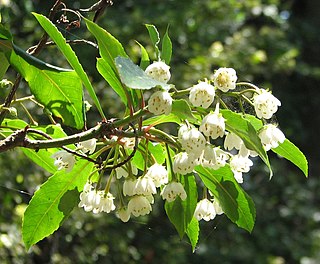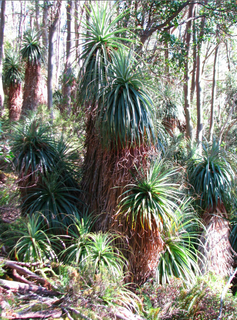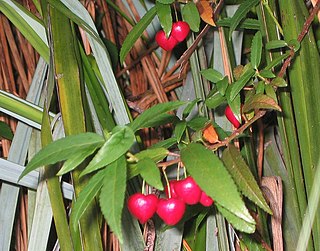
The Tasmanian temperate rain forests are a temperate broadleaf and mixed forests ecoregion in western Tasmania. The ecoregion is part of the Australasian realm, which includes Tasmania and Australia, New Zealand, New Guinea, New Caledonia, and adjacent islands.

Lomatia tasmanica, commonly known as King's lomatia, is a shrub of the family Proteaceae native to Tasmania. Growing up to 8 metres (26 ft) tall, the plant has shiny green pinnate (lobed) leaves and bears red flowers in the summer, but yields neither fruit nor seeds. King's lomatia is unusual because all of the remaining plants are genetically identical clones. Because it has three sets of chromosomes and is therefore sterile, reproduction occurs only vegetatively: when a branch falls, that branch grows new roots, establishing a new plant that is genetically identical to its parent.

Nothofagus cunninghamii, the myrtle beech, is an evergreen tree native to Tasmania and Victoria, Australia. It grows mainly in the temperate rainforests, but also grows in alpine areas. It is not related to the Myrtle family. It is often referred to as Tasmanian myrtle within the timber industry. N. cunninghamii was proposed to be renamed Lophozonia cunninghamii in 2013. There has been some controversy over the change in name from Nothofagus to Lophozonia.

Anodopetalum biglandulosum is a Tasmanian endemic shrub or small tree species that is a common component of Tasmania's cool temperate rainforests. It is commonly known as horizontal scrub because of its habit of growth. It is the sole species in the genus Anodopetalum.

Eupomatia laurina, commonly named bolwarra or sometimes native guava or copper laurel, is a species of shrubs to small trees, of the Australian continent ancient plant family Eupomatiaceae. They often grow between 3 and 5 m tall, larger specimens may attain 15 m (50 ft) and a trunk diameter of 30 cm (12 in). They grow naturally in eastern Australia and New Guinea. In Australia, they grow as far south as Nowa Nowa in the humid forests of the warm temperate east of the state of Victoria through eastern New South Wales and Queensland north to tropical Cape York Peninsula. They are one of the ancient lineages of flowering plants, usually growing as part of an understorey in rainforests or humid Eucalypt forests.

Anopterus macleayanus, commonly known as Queensland laurel or Macleay laurel, is a shrub or small tree in the family Escalloniaceae. It is native to Queensland and New South Wales in Australia.

Gaultheria hispida, commonly known as the copperleaf snowberry, is an endemic eudicot of Tasmania, Australia. It is an erect multi-branched shrub, that can be found in wet forests and alpine woodlands. Its berries appear snowy white and leaves are tipped with a copper tinge, hence the common name.

Richea pandanifolia, the pandani or giant grass tree, is a distinctive endemic Tasmanian angiosperm. It is dicot of the family Ericaceae and is found in central, western and south west Tasmania. It is a favourite among hikers and nature lovers.

Leptospermum lanigerum, commonly known as the woolly teatree, is a small tree or medium shrub from the plant family Myrtaceae. Its common name derives from the conspicuously hairy capsules produced as fruit, along with the fine, silky hairs present on branches and leaves. L. lanigerum is widespread in many habitats, particularly in waterlogged areas such as moist, sandy coastal heaths, on river banks, riparian scrub, woodlands and on the fringe of montane grasslands. This species is endemic to Australia, with native populations occurring in New South Wales, South Australia, Tasmania and Victoria.

Cryptocarya laevigata, known as the glossy laurel or red-fruited laurel, is a rainforest plant growing in eastern Australia. The natural range of distribution is rainforest understorey on fertile soils, from the Richmond River, New South Wales to Cairns in tropical Queensland. Often seen in association with the White Booyong.

Telopea oreades, commonly known as the Gippsland-, mountain- or Victorian waratah, is a large shrub or small tree in the family Proteaceae. Native to southeastern Australia, it is found in wet sclerophyll forest and rainforest on rich acidic soils high in organic matter. No subspecies are recognised, though a northern isolated population hybridises extensively with the Braidwood waratah (T. mongaensis). Reaching a height of up to 19 metres, T. oreades grows with a single trunk and erect habit. It has dark green leaves with prominent veins that are 11–28 centimetres (4.3–11 in) long and 1.5–6 cm (0.6–2.4 in) wide. The red flower heads, known as inflorescences, appear in late spring. Each is composed of up to 60 individual flowers.

Gahnia grandis is a tussock-forming perennial plant found in southeastern mainland Australia and Tasmania.

Eucalyptus amygdalina, or black peppermint, is a species of Eucalyptus which is endemic to Tasmania, Australia. It was first described by Labillardiere in 1806. It is one of the most common eucalypts in the state, where it is often a tree in sclerophyll forest or a shrub in open scrub and heath. It is known to integrate with E. nitida and E. pulchella.

Persoonia muelleri, commonly known as Mueller’s geebung, is a shrub endemic to Tasmania. It forms a shrub in open areas of wet forests in the west and northeast of the state. It is occasionally confused with P. gunnii though it has larger flowers and longer, straighter leaves.

Cenarrhenes is a monytypic genus in the family Proteaceae containing the single species Cenarrhenes nitida, known as the Port Arthur plum or native plum. Cenarrhenes nitida is an evergreen shrub to small tree endemic to the rainforests and scrublands of western Tasmania. It bears white flowers in late spring followed by the development of fleshy fruit.

Monotoca scoparia, commonly known as prickly broom heath, is a widespread native species across south-eastern Australia. Monotoca scoparia was formerly in the family Epacridaceae but now belongs to the family Ericaceae. Monotoca is an endemic Australian genus with 17 described species occurring in all states.

Hakea lissosperma, commonly known as needle bush and mountain needlewood, is a species of Hakea native to parts of south eastern Australia.

Orites diversifolia (=diversifolius), commonly known as variable orites, is a member of the family Proteaceae and is endemic to Tasmania. The common name stems from the variable form of the leaves, which range from entire and linear to serrated and ovate. It is a common shrub in lowland rainforest, subalpine woodland and scrub.
Monotoca glauca, known as goldy wood, is a heath family shrub endemic to Tasmania, Australia and is one of 17 described Monotoca species. It is a widespread and abundant understory species found on the margins of wet eucalypt forests and logged areas.

Aristotelia peduncularis, also known as heartberry, is a shrub in the family Elaeocarpaceae, endemic to the wet forests of Tasmania




















